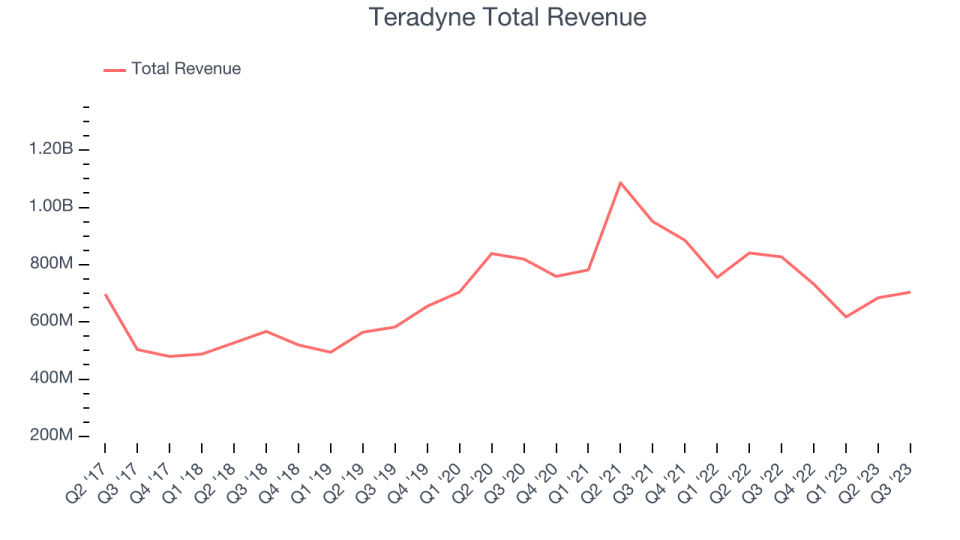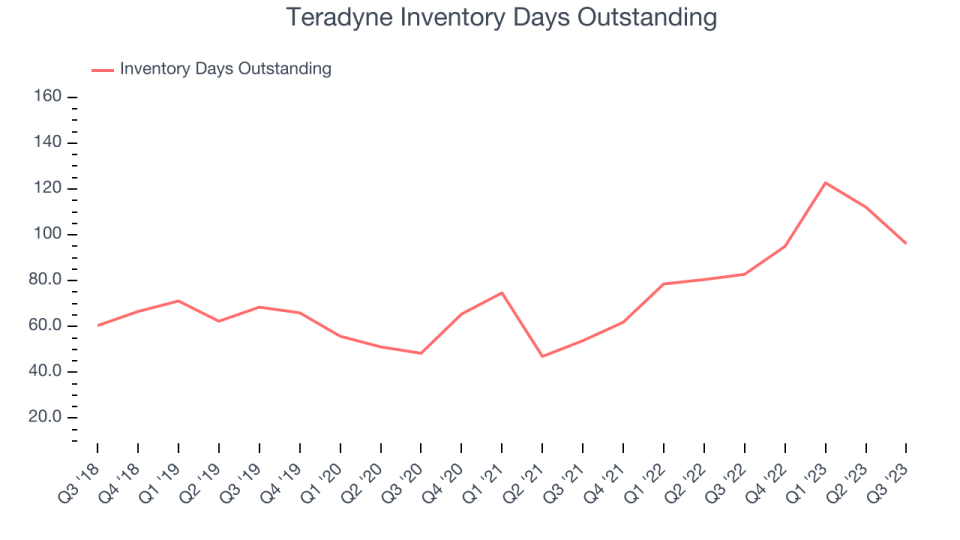Teradyne (NASDAQ:TER) Surprises With Q3 Sales But Quarterly Guidance Underwhelms

Semiconductor testing company Teradyne (NASDAQ:TER) reported Q3 FY2023 results topping analysts' expectations , with revenue down 14.9% year on year to $703.7 million. However, next quarter's revenue guidance of $670 million was less impressive, coming in 2.52% below analysts' estimates. Turning to EPS, Teradyne made a GAAP profit of $0.78 per share, down from its profit of $1.10 per share in the same quarter last year.
Is now the time to buy Teradyne? Find out by accessing our full research report, it's free.
Teradyne (TER) Q3 FY2023 Highlights:
Revenue: $703.7 million vs analyst estimates of $683.6 million (2.94% beat)
EPS (non-GAAP): $0.80 vs analyst estimates of $0.73 (9.7% beat)
Revenue Guidance for Q4 2023 is $670 million at the midpoint, below analyst estimates of $687.3 million
Free Cash Flow of $139.7 million, up 35% from the previous quarter
Inventory Days Outstanding: 96, down from 112 in the previous quarter
Gross Margin (GAAP): 56.6%, down from 58.7% in the same quarter last year
"Greater than planned Robotics shipments and sequential growth in Semiconductor Test combined to drive sales and profits to the high end of our Q3 guidance range," said Teradyne CEO Greg Smith.
Sporting most major chip manufacturers as its customers, Teradyne (NASDAQ:TER) is a US-based supplier of automated test equipment for semiconductors as well as other technologies and devices.
Semiconductor Manufacturing
The semiconductor industry is driven by demand for advanced electronic products like smartphones, PCs, servers, and data storage. The need for technologies like artificial intelligence, 5G networks, and smart cars is also creating the next wave of growth for the industry. Keeping up with this dynamism requires new tools that can design, fabricate, and test chips at ever smaller sizes and more complex architectures, creating a dire need for semiconductor capital manufacturing equipment.
Sales Growth
Teradyne's revenue has been declining over the last three years, dropping by 1.58% on average per year. This quarter, its revenue declined from $827.1 million in the same quarter last year to $703.7 million. Semiconductors are a cyclical industry, and long-term investors should be prepared for periods of high growth followed by periods of revenue contractions (which can sometimes offer opportune times to buy).

Even though Teradyne surpassed analysts' revenue estimates, this was a slow quarter for the company as its revenue dropped 14.9% year on year. This could mean that the current downcycle is deepening.
Teradyne may be headed for an upturn. Although the company is guiding for a year-on-year revenue decline of 8.45% next quarter, analysts are expecting revenue to grow 14.3% over the next 12 months.
Our recent pick has been a big winner, and the stock is up more than 2,000% since the IPO a decade ago. If you didn’t buy then, you have another chance today. The business is much less risky now than it was in the years after going public. The company is a clear market leader in a huge, growing $200 billion market. Its $7 billion of revenue only scratches the surface. Its products are mission critical. Virtually no customers ever left the company. You can find it on our platform for free.
Product Demand & Outstanding Inventory
Days Inventory Outstanding (DIO) is an important metric for chipmakers, as it reflects a business' capital intensity and the cyclical nature of semiconductor supply and demand. In a tight supply environment, inventories tend to be stable, allowing chipmakers to exert pricing power. Steadily increasing DIO can be a warning sign that demand is weak, and if inventories continue to rise, the company may have to downsize production.

This quarter, Teradyne's DIO came in at 96, which is 23 days above its five-year average. These numbers suggest that despite the recent decrease, the company's inventory levels are higher than what we've seen in the past.
Key Takeaways from Teradyne's Q3 Results
With a market capitalization of $14.1 billion, a $716.5 million cash balance, and positive free cash flow over the last 12 months, we're confident that Teradyne has the resources needed to pursue a high-growth business strategy.
We were impressed by Teradyne's strong improvement in inventory levels. We were also glad its revenue and EPS outperformed Wall Street's estimates, driven by a huge beat in its semiconductor test products - its core competency. That growth, however, was offset by lower-than-expected revenue from its system and wireless test products. Looking ahead, its revenue guidance for next quarter underwhelmed. Overall, this was a mediocre quarter for Teradyne. The stock is flat after reporting and currently trades at $87.4 per share.
So should you invest in Teradyne right now? When making that decision, it's important to consider its valuation, business qualities, as well as what has happened in the latest quarter. We cover that in our actionable full research report which you can read here, it's free.
One way to find opportunities in the market is to watch for generational shifts in the economy. Almost every company is slowly finding itself becoming a technology company and facing cybersecurity risks and as a result, the demand for cloud-native cybersecurity is skyrocketing. This company is leading a massive technological shift in the industry and with revenue growth of 50% year on year and best-in-class SaaS metrics it should definitely be on your radar.
Join Paid Stock Investor Research
Help us make StockStory more helpful to investors like yourself. Join our paid user research session and receive a $50 Amazon gift card for your opinions. Sign up here.
The author has no position in any of the stocks mentioned in this report.
